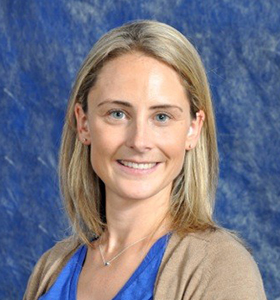Dr. Ashley Smyth has joined the Soil and Water Sciences Department as an Assistant Professor of Biogeochemistry at the Tropical Research and Education Center. We asked her to tell us about her background and future plans.

Can you tell us a little about your road to UF?
Before arriving at UF I worked in the Outer Banks of North Carolina, the shores of Chesapeake Bay, and the tallgrass prairies of Kansas!
My interest in biogeochemistry began as an REU (Research Experience for Undergraduates) student at the Patrick Center for Environmental Research in Philadelphia. During that time, I grew to love days in the field being covered with mud while also getting satisfaction from analyzing and processing data. I was amazed by the role that microscopic organisms in the sediment had in structuring our ecosystem. Figuring out the story the marsh was trying to tell solidified my desire to conduct similar research at the graduate level.
I enrolled in a Masters program at UNC-Chapel Hill to examine nitrogen dynamics in salt marshes. My research revealed that oyster reefs, not marshes, were the estuarine habitat with the highest rate of nitrogen removal via denitrification, but over-harvesting and disease had drastically reduced the oyster population. Based on this finding (and funding), I decided to stay at UNC for my PhD to gain a better understanding of how oyster reef restoration can remove nitrogen that would otherwise contribute to eutrophication.
While the water quality benefits of oyster restoration were becoming clearer, little was known about oyster aquaculture. Oyster aquaculture can be an alternative to restoration, providing the same ecosystem services with additional economic benefits. As a David H. Smith Conservation Research Fellow, I partnered with Virginia Sea Grant and the Virginia Institute of Marine Science to assess the efficacy of including oyster aquaculture in nutrient trading credit programs designed to manage pollutants in Chesapeake Bay.
Following my Smith Fellowship, I moved just about as far away from the ocean as one could get—Lawrence, Kansas. At the University of Kansas, I shifted my focus to the carbon cycle and examined the drivers of greenhouse gas emissions in restored wetlands. I enjoyed the Midwest, but my love for the ocean brought me back to the East Coast and the University of Florida.
What part of your research are you most proud of or excited about?
I’m most excited about being covered in mud! I still get this sense of exhilaration when I take a sediment core. Within each core there is a whole world, invisible to the naked eye, that controls the availability of key nutrients. Every sample I take has its own story to tell and offers new insights into how ecosystems function.
Are there other specific projects or collaborations you have underway?
South Florida is undergoing rapid changes in land-use and land-cover. The location of the Tropical Research and Education Center, at the interface of the Redland agricultural area, Biscayne Bay, and the Everglades, offers a unique opportunity to answer fundamental questions about how human activities alter elemental cycles. I’m excited to work with researchers in the Soil and Water Sciences Department and the broader UF community to foster new ideas for the conservation and management of South Florida’s natural resources, such as seagrass beds and coral reefs. I am also working with other members of the Sea Level Resilience cluster to study how sea level change in South Florida affects soil and water quality.
What is your vision for your research and extension programs?
My vision for my program is to help bridge the gap between theory and application and increase public awareness of the environmental challenges that face South Florida. The goals of my research are to improve our understanding of the interaction between South Florida’s natural ecosystems and water quality.
What do you foresee as being the biggest challenge ahead?
Many global citizens acknowledge that climate change is the most pressing environmental issue of our time, yet, there is still strong denial from key policymakers that human activities contribute to global warming. Communicating the results of scientific research across all fields and engaging with multiple stakeholders is essential to protecting natural resources for future generations. There are some magical places in South Florida and we are running out of time to enjoy them unless we change the actions and attitude of the very people who are best positioned to have a lasting impact regarding climate change.
What motivates you most to go to work every day?
I love what I do. Whether that is being out on the water or spending the day in my office writing, every day I discover something new about the world around me. Some days I gain that information from journal articles, and other days it is from interacting with my colleagues at TREC and the SWS department. I go to work and get to hear stories from researchers and people in the community. We all come from different backgrounds and have different perspectives, but we are all brought together by our passion and interest in conserving and preserving Florida’s natural resources.
 0
0
